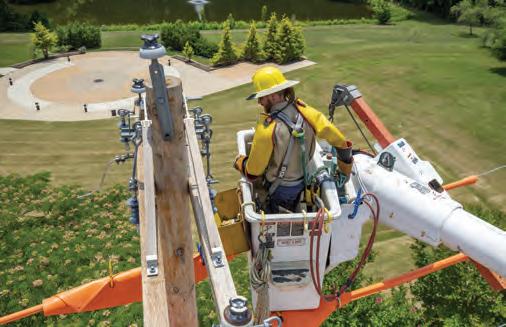
20 minute read
Witnessing Government in Action Students find inspiration on the 2022 Youth Tour
from 2022-08-SREMC
New Lineworker Training Unit Creates Realistic Experience
NC co-ops are industry leaders in using the technology
A new addition to the lineworker training field at Nash Community College incorporates a more realistic element to overhead line work training: high voltage.
Installed earlier this year, the new Timpson training unit allows lineworkers to train using real-world voltage while keeping the current to a safe, non-lethal level. “It has always been a challenge to provide advanced training to linemen beyond simulation — there is a quick learning curve transitioning from de-energized work to energized work,” said Farris Leonard, director of Job Training & Safety Field Services (JT&S) for North Carolina’s Electric Cooperatives. “This allows lineworkers to train on a live line in a safe way.”
Three classes will utilize energized training this year. Students of JT&S sessions who trained with the unit report that working on a live line increased focus.
“Working the lines hot really made us all think twice and move once,” said Ethan Hurley, apprentice lineman IV with Randolph EMC. “I think it’s really big step forward.”
Although some investor-owned utilities, including Duke Energy, train on Timpson units, North Carolina’s electric cooperatives are the first cooperative utilities in the country to utilize the technology. Leonard hopes the technology will be adopted by electric co-ops in other states now that it’s been proven in North Carolina.
“We see training as an investment in people,” Leonard said. “This unit is a further investment in safety that will sharpen skills and provide real-time feedback during training.”

Denny Gainer Denny Gainer

Big Questions About Our Brighter Future

Your residential solar questions answered
Q:What is the average cost of a residential solar installation?
A: Prices may vary across the country, but the National Renewable Energy Laboratory periodically publishes reported photovoltaic (PV) prices. For the first half of 2021, the average price for PV systems in the U.S. was as follows: ■ $2.70/watt (W) to $3.90/W for residential systems (A 10-kilowatt (kW) system, therefore, could cost between $27,000 and $39,000.) ■ $1.60/W to $2.50/W for non-residential systems ■ $0.90/W to $1.90/W for utility-scale systems Q:What is the life expectancy of solar panels? A:While there is no specific end-date for the productive life of a solar panel, production levels will decrease over time. The performance of solar panels is typically warrantied for 20 to 25 years, with a guarantee of 90% production at 10 years and 80% production at 25 years. After the end of the warranty, the solar panels can still produce electricity, but their level of output is no longer guaranteed. In addition to performance warranties, solar panels typically have an equipment warranty that guarantees they will operate 10 to 12 years without failing.
—Tim Lupo, Advanced Energy solar engineer
Editor’s note: What happens to those panels when they reach the end of their lifespan? Advanced Energy will provide answers to that question and more in future issues of Carolina Country.
WITNESSING government IN ACTION
The scene has been playing out for decades: A group of North Carolina high school students, dressed in their best church clothes, gathers on the gleaming white steps of the Capitol Building in Washington, D.C. It’s hot and likely humid — even by North Carolina standards — but there’s an energy about the group that can’t be stifled. They pose for some photos and then head inside, where they’ll learn about the building’s 200-year-old history first-hand, and meet senators and members of Congress face-to-face. This is the NC Electric Cooperative Youth Tour, and in June it was back in action after two years of virtual events during the pandemic. The Youth Tour is part of a national program that brings high schoolers, sponsored by their local electric cooperatives, to our nation’s capital for a week of learning and camaraderie. Students learn about the co-op business model, witness civics in action, and—in the spirit of the expression “work hard, play hard” — tour the sights and have some fun.
“After two years of not being in D.C. on Youth Tour, we were thrilled to finally resume the more than 50-year tradition of bringing North Carolina’s best and brightest to our nation’s capital,” says Paul Mott, Youth Tour coordinator and government affairs specialist for North Carolina’s Electric Cooperatives. “During the week, 29 students who represent the best our state has to offer were given the chance to learn more about our great country and the electric co-ops who serve our communities.”
Co-op 101 Before being selected to participate in the Youth Tour, students likely hadn’t given much thought to their electric cooperatives. But by the time students boarded the bus in Raleigh, they had a firm understanding of the cooperative business model and how a co-op works, having formed one themselves.
“During the orientation sessions, students learn what a co-op is and the seven Cooperative

Students make new friends, find inspiration on the 2022
Youth Tour By Scott Gates
Hiteshue Selected for YLC
Youth Tour participants have returned home to share memories from the trip, but the journey is just beginning for Madeline Hiteshue, a member of EnergyUnited and a senior at Pine Lake Preparatory in Mooresville. Hiteshue was selected by her peers to represent North Carolina on NRECA’s Youth Leadership Council (YLC), which brings together one Youth Tourist from each state to participate in a national leadership workshop. As this year’s YLC winner, Madeline will attend the 2023 Annual Meeting of North Carolina’s Electric Cooperatives in Raleigh, as well as NRECA’s 2023 PowerExchange in Nashville. Read more about her Youth Tour experience on page 4.

Principles they’re guided by, giving some thought to how their local electric co-ops demonstrate those principles in the community,” Mott says.
Students also formed the “H2O Co-op” to manage snacks and drinks during the trip. The group elected a five-member board of directors, which then interviewed students interested in the co-op manager position. Once the manager was hired, they selected an assistant manager to load coolers each day and collect “Co-op Bucks” from Youth Tourists for snacks and drinks (everyone received 25 Co-op Bucks for the trip). The board of directors could adjust prices throughout the trip based on demand.
Once in D.C., Youth Tourists also learned about national and international co-op programs from the National Rural Electric Cooperative Association (NRECA), the trade association serving the nation’s electric cooperative network. A trip to the Hill One of the highlights of the trip each year is a visit to the Capitol for a tour and an opportunity to meet North Carolina’s elected officials and members of their staff. This year, NC Youth Tourists met with Rep. Ted Budd; Rep. G.K. Butterfield; Rep. Virginia Foxx; Rep. Richard Hudson; Rep. Kathy Manning; Rep. Greg Murphy; and staffers for Sen. Richard Burr, Sen. Thom Tillis, Rep. Patrick McHenry and Rep. David Price.
“One thing that inspired me was talking to North Carolina’s representatives,” said Vivian Villa Tapia, a 2022 Youth Tourist sponsored by Central Electric. “All of their stories and speeches made me want to become more like them, and to help strive for change in America.”
Elected officials fielded questions from students and discussed topics including their motivations for serving as an elected official and advice for young adults moving into a professional career, as well as dispelling misconceptions about how elected officials work together on the Hill — they operate in a more civil manner than many assume.
Congressional staff members, often not much older than the Youth Tourists themselves, discussed where they went to college and how they came to work in Washington, D.C., stressing that there’s no one path to work in government.
“Ensuring students can learn about our government in Washington, D.C., is critical to supporting the next generation of leadership in our nation,” says Rep. Hudson. “Meeting with the Youth Tour each year is always a honor, and I appreciate North Carolina’s electric cooperatives for once again providing this opportunity to students across our state.”
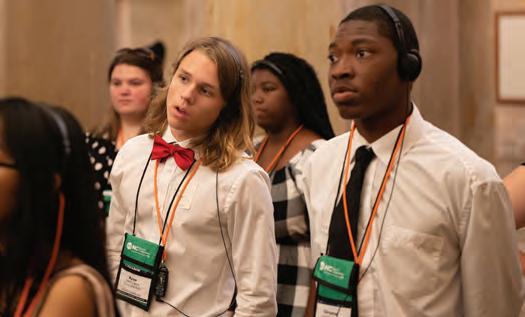


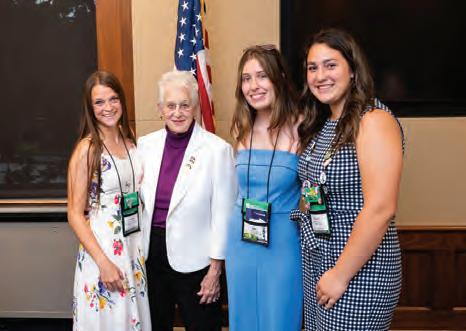
“We’re the next generation, meaning the country is in our hands.... We have to be the voice of reason and change.”

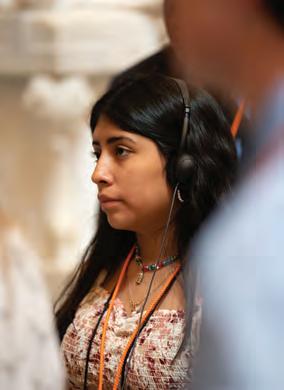
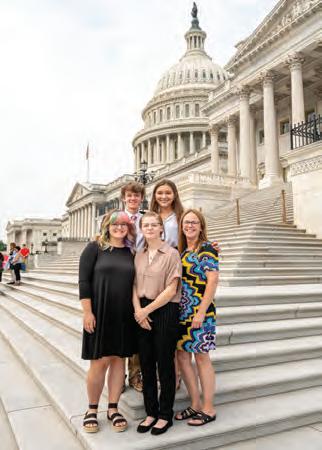
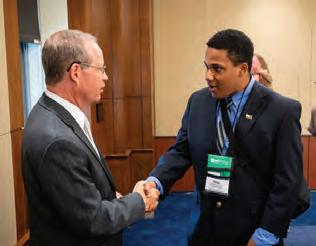
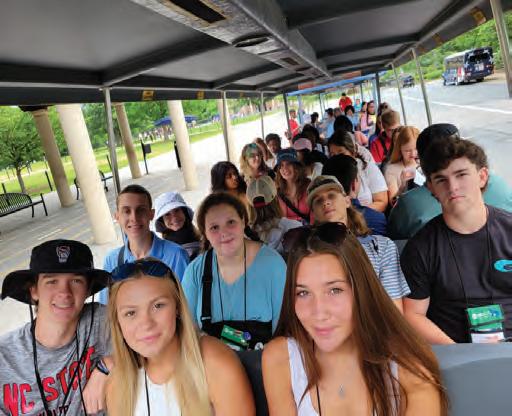

North Carolina Electric Cooperatives
Washington D.C.



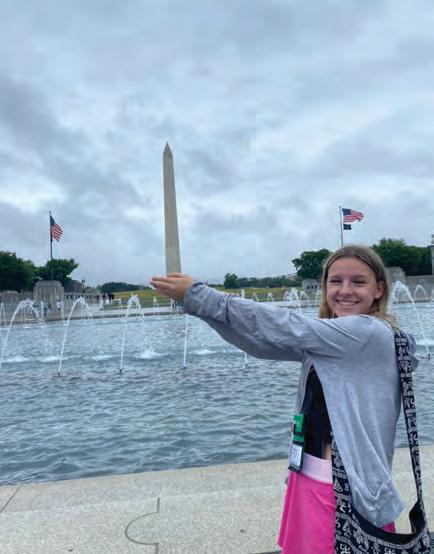
WANT TO BE A YOUTH TOURIST? Find out more information about the trip from a national perspective at youthtour.coop, and if you’re interested in applying, contact your local electric cooperative for more information.
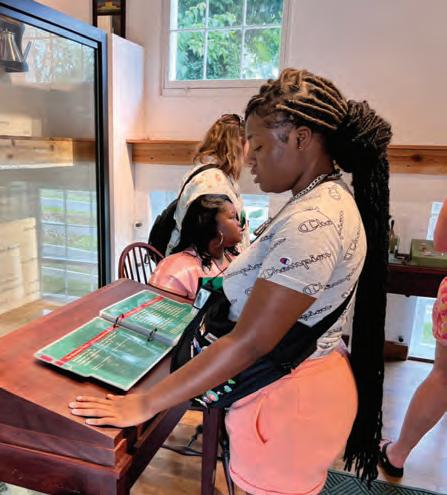
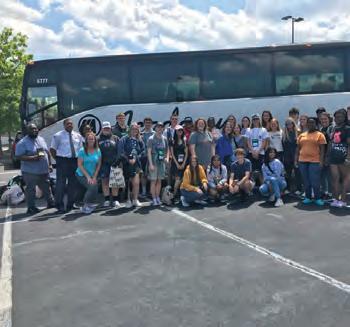
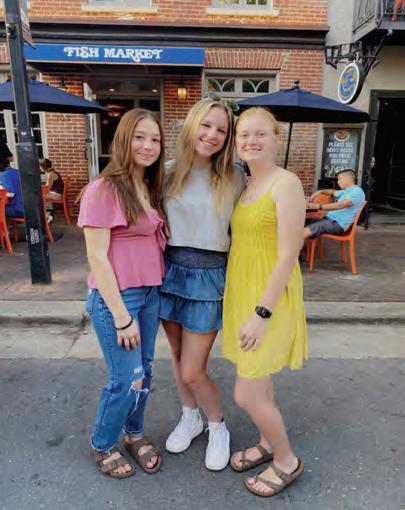
Seeing the sights For many Youth Tourists, the trip marks their first to Washington, D.C., and their time there is well spent. This year’s itinerary included a Potomac River cruise on the Spirit of Washington; tours of the National Cathedral, Old Town Alexandria and monuments on the National Mall; visits to Smithsonian museums and the United States Holocaust Memorial Museum; and a visit to Arlington National Cemetery, where students witnessed the changing of the guard at the Tomb of the Unknown Soldier.
There were also plenty of opportunities for students to relax and have fun, including bowling, dinner at the Hard Rock Café, and meetings with other Youth Tourists from around the country to share experiences and trade state pins.
“Every day was a different experience and allowed you to see what Washington, D.C., had to offer, while also building bonds with people you never knew existed before the Youth Tour — not only from North Carolina, but from all over the U.S.,” says Miciah Freeman, a 2022 Youth Tourist sponsored by Roanoke Electric.
Ask Youth Tourists what they’ll carry with them from the trip, and they’ll be quick to mention the unique experiences, friendships made and a new appreciation for electric co-ops. But many hit on another takeaway that can stick with them for years: inspiration to better their communities and our country.
“We’re the next generation, meaning the country is in our hands,” Freeman adds. “We have to be the voice of reason and change.”



Stauer® Impossible Price ONLY $39


Praise for DiamondAura®
“So much sparkle and the play of light on DiamondAura® beats any diamond!” — D.D. from Columbus, OH How to Win at Love

A classic tennis bracelet serves up over 10 carats of sparkle for a guaranteed win



It was the jewelry piece that made the world stop and take notice. In the middle of a long volley during the big American tennis tournament, the chic blonde athlete had to stop play because her delicate diamond bracelet had broken and she had to nd it. e tennis star recovered her beloved bracelet, but the world would never be the same. From that moment on, the tennis bracelet has been on the lips and on the wrists of women in the know. Once called eternity bracelets, these bands of diamonds were known from then on as tennis bracelets, and remain the hot ticket item with jewelers.
We’ve captured this timeless classic with over 10 total carats of DiamondAura®, our signature diamond alternative stone. is sparkling marvel rivals even the nest diamonds (D Flawless) with its transparent color and clarity, and both are so hard they can cut glass. Don’t believe me? e book “Jewelry and Gems – e Buying Guide,” praised the technique used in our diamond alternative DiamondAura®: “ e best diamond simulation to date, and even some jewelers have mistaken these stones for mined diamonds,” it raved. For comparison, we found a similarly designed 10 carat tennis bracelet with
Join more than 1 million thrilled diamondAURA® customers



D Flawless diamonds from another company that costs $57,000! Want to look like a million bucks without stressing over losing or damaging something that cost you a fortune? e Love Wins Tennis Bracelet is a simple strand of glittering gems in precious sterling that epitomizes elegance.
e rst time we o ered this bracelet, we sold out literally
in minutes. It was our fastest selling product of 2021. It took six months to get it back in stock — Get yours before we run out!
Jewelry Speci cations:
• 10 ¾ ctw of the Ultimate Diamond Alternative®,
DiamondAura® • Rhodium- nished .925 sterling silver setting • Fits wrists to 7 ½"
Love Wins Tennis Bracelet (10 ¾ ctw) $399 $39* + S&P
*Special price only for customers using the offer code.
1-800-333-2045
Your Offer Code: LWB207-01
Stauer, 14101 Southcross Drive W., Ste 155, Dept. LWB207-01, Burnsville, MN 55337 www.stauer.com Stauer® | AFFORD THE EXTRAORDINARY ®


Save 10%1 on energy use with a FREE
ecobee smart thermostat.
As a member of South River EMC, you can lower your energy costs and make your home more energy efficient this summer. For a limited time, get a FREE2 ecobee3 lite smart thermostat with FREE professional installation when you enroll in Connect to Save. As a bonus, you will also receive a $50 annual incentive for each year you participate.
Enroll in this exclusive member offer today!
Scan to learn more.
Protecting Children in a Digital Age

Keeping a watchful eye on your kids requires an increasing level of tech savviness many parents find intimidating. Not only are your kids vulnerable to bad actors online, but your family’s personal information could be at risk as well.
Learn how to protect your children and family in this digital age with these tips:
Elementary-age children ■ Encourage open communication. Have conversations about what your kids see and do online and talk with them about potential dangers. Avoid lecturing in favor of an open exchange of information. ■ Make their inherent interest in privacy work in your favor. Kids in this age group, particularly toward the middle school years, understand the concept of privacy and value it immensely. Use that context to help them understand what goes online is there to stay. Talk about what kinds of information should always be kept private, including identifying details like addresses and social security numbers. ■ Stay alert. Not all apps are completely safe (even the ones you can access from trusted stores) and not all filters are foolproof. Keep close tabs on what your kids are downloading by reading comments and reviews, and regularly monitoring what kind of content they see.
Middle school and high school kids ■ Continue talking about privacy. You can never have too many conversations about privacy. What seems like harmless sharing on social media can be quite revealing.
For example, frequent posts about visits to a favorite store or restaurant can allow a predator to begin tracking behavior patterns that make your child a target. It’s
also important for kids to understand how their privacy settings work. For example, settings that allow exposure to friends of friends make their visibility to strangers much broader than they may realize. ■ Help manage their online reputation. Behaviors that once resulted in a day or two of hallway chatter can now live forever. Documenting mischief online is only fun until it spills over into real life and everyone sees those mistakes in full color — including prospective future employers. ■ Be clear about your position on bullying. From the safe distance of a screen, it’s easier for kids (and adults) to say things they’d never say in person. Teach your kids to handle problems constructively offline and avoid engaging in attacks on others through social media, email and other platforms.
College students ■ Reinforce the risks. Once they’re on their own, kids may feel more liberated to make their own choices online.
However, college students are easy prey for identity theft and worse. Remind them what’s at stake if they fail to protect their identity and private information, like where they live and what they do on a regular basis. ■ Teach smart practices. With all the independence that comes with college life, this is an ideal time for your student to take personal responsibility for his or her online security, including learning about virus protection, updating software, avoiding scams and backing up data. For more practical advice for everyday family matters, visit eLivingtoday.com.
Make Memories Last a Lifetime
By Rue Reynold
Spending time with loved ones or visiting new places are experiences you never want to forget. Recording such events allows you to relive these moments long after they’ve passed. Here are a few ways to preserve memories to share for generations.
Audio or video recording Live recordings allow you to keep the exact thoughts in your mind or event you witnessed. The feeling of hearing a child’s first words or a graduation speech is something you can hold onto for years to come.
Photography A picture may be worth a thousand words, but your experiences are invaluable. Photography is one of the simplest ways to capture memories as they happen. It also allows you to appreciate all the little things you might have missed in the background while focusing on the main subject. Journaling Keeping a written record of your goals and past events is an excellent way to see how much you’ve grown and what changed from the past to the present. A journal can also be a source of inspiration to share with loved ones.
Scrapbooking Organizing your photos and personalizing the blank space around them is the ultimate marriage between imagination and context. A scrapbook is especially meaningful down the line when future generations read it as if they’re reliving the memories through your eyes. Living in the present allows you to appreciate the here and now, but preserving some of your precious moments can also touch hearts far into the future.

Rue Reynold is the editorial assistant for Carolina Country.
Love Carolina Country? Don’t miss an issue!
Subscribe and get Carolina Country in your mailbox every month for just $1 an issue!
Co-op Members, check with your electric cooperative to find out if they offer complimentary subscriptions as a benefit of membership.
Yes! Please start my subscription.
NAME

MAILING ADDRESS
CITY STATE ZIP
PHONE NUMBER (If we have questions)
1 Year (12 issues) $12 2 Years (24 issues) $24 Check Enclosed Scan to Subscribe!
South River EMC Communicator
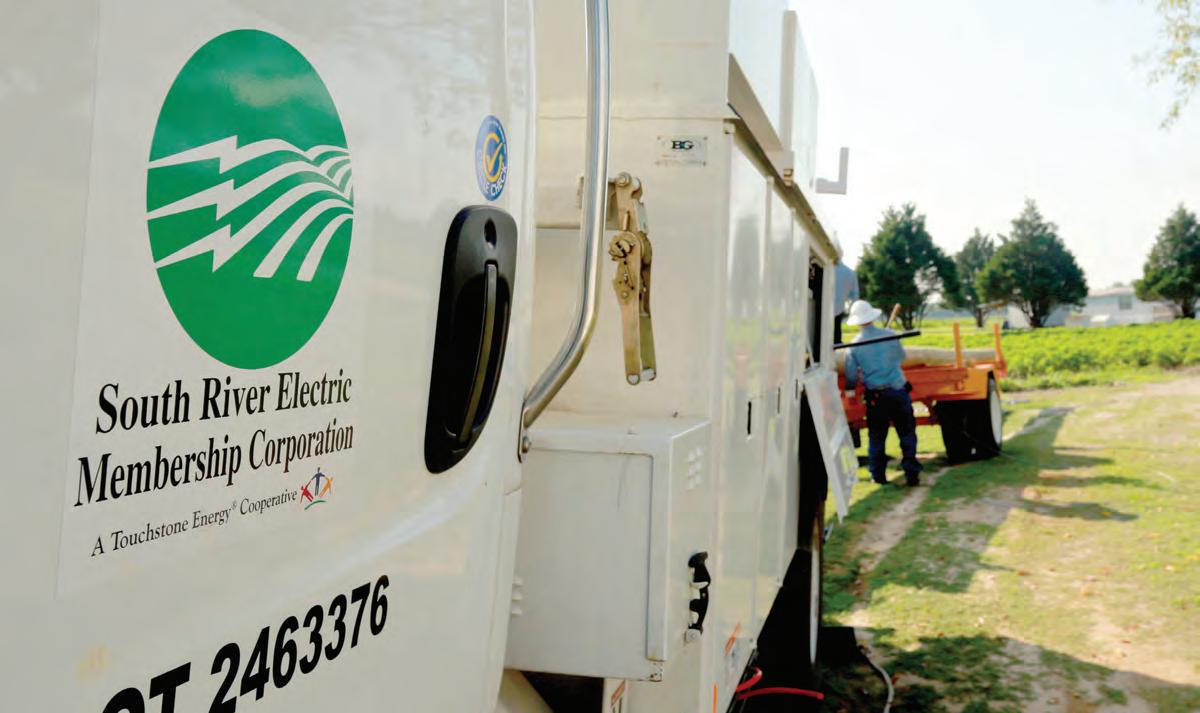

REFUND ALLOCATED
As a not-for-profit utility, we give money back! We don’t have stockholders. We aren’t a sole proprietorship. What we are is a Cooperative, which means that we are owned by each person who has an electric account with our company.

That’s you, you're part of something special—you’re a member.
So, at the end of each year, after all bills are paid, any remaining amount, called margins, is allocated to be refunded to members as capital credits.
INSIDE THIS ISSUE
Back to school this month, keep your eyes on the road.
Distracted Driving
Safety For Hunters
Fields of Honor
Advise Guys
Once we completed our audit for 2021, the allocation of the margins was made. Our end-of-year margins totaled $13,365,613.55 or 0.1346382095 percent of revenues.
What does this mean to you? If your electric bills in 2021 totaled $1,000, then you would be earmarked to receive a refund of $134.63. The refund will be returned as $26.93 in November and the remaining $107.70 in 19 years. The amount that is retained for 19 years is used as operating capital by the Cooperative. Capital credits are typically retired in November. Members whose refund is less than $100 will receive a bill credit. Members whose refund is $100 or greater will receive a check.
If you think you, or a family member, might have an unclaimed capital credit refund, visit sremc.com/capital-credits and see if your name appears on the list. If so, download the claim form and submit it to our office.
You can trust that we are always looking out for you, whether it’s in our daily work or refunding your money. We are all in this together.


Some temptations are hard to resist. Like turning down that last piece of chocolate cake.
While driving, we typically hear that “ding” on our phone alerting us to a text or call coming through, and we sometimes feel the urgent need to check it. We know we shouldn’t, but we reason that we’re going to make an exception—just this once.
So, why do we indulge in behavior we know to be wrong, dangerous and in many states, illegal? According to AAA research, most people feel they are better-than-average drivers.
Afterall, we have busy lives and are accustomed to multitasking.
But mounds of research and thousands of deaths every year prove otherwise.
August is Back to School Safety Month. As a new school year begins with young drivers and school buses back on the road, it's a good time to review the dangers of distracted driving.
The reality is that using a phone while driving creates enormous potential for injuries and fatalities. Distractions take a motorist’s attention off driving, which can make a driver miss critical events, objects and cues, potentially leading to a crash.
According to the National Highway Traffic Safety Administration, one of every 10 fatal crashes in the U.S. involves distracted driving, resulting in more than 3,000 deaths annually. This statistic is heartbreaking considering so many of these accidents could easily be avoided if we’d simply put down our phones while driving.
Distracted driving is considered any activity that diverts our attention, including texting or talking on the phone, and adjusting the navigation or entertainment system.
Texting, by far, is one of the most dangerous distractions. Sending or reading one text takes your eyes off the road for an average of five seconds. At 55 mph, that's like driving the length of an entire football field with your eyes closed.
In addition to refraining from texting while driving, help keep the roads safe by moving over for first responders and other emergency vehicles. Additionally, if you see utility crews conducting work near the roadside, move over when possible and give them extra space to perform their work safely.
At South River EMC, safety is foremost in everything we do—for our employees and the members of the communities we serve. We routinely remind our crews of the dangers of distracted driving, and we hope you’ll have similar conversations with your teens who may be new to the roadways and are especially susceptible to the lure of technology.
Let’s work together to keep everyone safe on the roads. Remember: that text can wait and waiting just might save a life.




